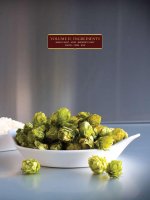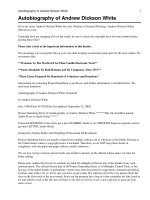VOLUME II: INGREDIENTS ppt
Bạn đang xem bản rút gọn của tài liệu. Xem và tải ngay bản đầy đủ của tài liệu tại đây (733.36 KB, 20 trang )
ii.13
volume ii : ingredients
ingredient
ii.14
beer : a reference guide
ingredient
volume ii : ingredients
beer : a reference guide
ingredient
ii.15
volume ii : ingredients
barley malt
The grain that starts it all,
barley often receives billing as the “soul” of great brews.
Barley is one member of the family of cereal grains that
comprises the majority of the world’s food supply. This
family also includes wheat, corn, rice, rye, oats and other
grains such as sorghum and millet.
row, row, row your barley
ii.16
beer : a reference guide
volume ii : ingredients
barley malt
™
vs.
The physical structure of the barley kernel
does not change among the different vari-
eties. Each kernel consists of the following
ve major structural components:
The husk protects the grain from in-
sect and microbe attack.
The pericarp keeps the kernel dor-
mant before it is ready to grow by blocking
water and oxygen from the seed.
The aleurone layer produces enzymes
during germination — when the kernel
starts to turn into a plant.
The endosperm serves as a stored
food source for the embryo during germi-
nation.
The embryo is the living part of the
seed. During germination, the embryo
grows roots and a stem that becomes
the barley plant. Enzymes produced by
the aleurone layer break down the endo-
sperm to sugars that the embryo feeds on
until it can absorb nutrients from external
sources.
beer : a reference guide
ii.17
volume ii : ingredients
ii.18
beer : a reference guide
volume ii : ingredients
barley as a protein source?
the malting process
1 Barley cleaning and grading.
2 Steeping, where the barley is
cycled through water soaks and air
rests to initiate germination.
3 Germination, where the barley remains
under controlled temperature, moisture
and oxygen conditions until it is fully
modied into the beginnings of a plant.
4 Kilning, where the modied barley is
heated to x its chemical content and
reduce its moisture content to a level
suitable for storage and milling. This
step also drives off unwanted avors
(grassy, green) and develops other
desirable ones (nutty, “malty,” toasted).
cleaning and grading
steeping
barley malt
beer : a reference guide
ii.19
volume ii : ingredients
barley malt
1 Kernel moisture has reached target value.
2 Embryos are viable; the grain is alive.
3 Undesirable husk components
have been extracted.
4 The rst sprout appearing in the
germination of seed has started.
5 Enzyme production has begun.
germination
²
time,mois-
ture,temperature and airow.
kilning
ii.20
beer : a reference guide
volume ii : ingredients
hops
Hops, the cone-shaped
clusters of blossoms from the vine-like hop plant, serve as
the “spice” of beer, imparting their own special character.
Not only do they contribute to beer’s avor and aroma,
but they also enhance foam formation. The female hop
bine produces all the hops used in brewing. Hop blossoms
develop into a 1- to 3-inch-long, cone-shaped formation
of “petals.” These petals contain small glands at their
base, which house the bitter resins and oils needed for
brewing.
the history
beer : a reference guide
ii.21
volume ii : ingredients
hops
where they like to live
a hop by any name
is not the same
Today, Hallertau, Germany,
and Yakima, Wash., are
the world’s largest
hop-growing areas.
ii.22
beer : a reference guide
volume ii : ingredients
hops
Saaz
Saaz: Hailing from the Czech Republic, this hop is more nicky
about the amount of daylight it receives and yields fewer hop
cones per acre, but offers a spicy, robust avor. It is a very tra-
ditional European aroma hop variety, has been grown for several
centuries and is used in Pilsner-style beers.
Santiam: A daughter of the German Tettnang variety and a tradi-
tional aroma hop, it is spicy and avor intense.
Spalt: Grown in the Spalt area of Germany, this hop has similar
characteristics to the Saaz hop.
Spalt Select: Another new, more disease-resistant, higher yield-
ing German aroma hop. The oil prole is chemically halfway be-
tween the old Spalt variety and Hersbrucker, but with a very low
cohumulone.
Tettnang: Grown in the Tettnang area of Germany, this hop has
similar characteristics to the Saaz hop.
Hallertau
Hallertau Mittelfrüh: Perhaps the most prestigious of the Euro-
pean aroma hop varieties, Hallertau hop has been grown for sev-
eral centuries and offers a wonderfully distinct oral and spicy
character.
Fuggle
Cascade: A distinct American hop widely used in many craft
beers. It is a very oral, citrusy hop with a unique aroma.
Fuggle: A classic English variety of hop. Fuggle is mild, spicy and
woody with a soft aroma.
Willamette: One of the most widely grown U.S. hops.
Brewers Gold
Other
Strisselspalt: Closely related to the Hersbrucker hop, Strissel
spalt is grown in the Alsace region of France. As a result, this hop
is sometimes referred to as Alsace.
Perle: Developed by the German Hop Research Institute for the
Hallertau growing region.
Goldings
Goldings: Another traditional English aroma variety used in mak-
ing ales, this hop has a delicate aroma.
While there are more than 100 documented hop
varieties in the world, they all can be categorized in one
of six classes:
beer : a reference guide
ii.23
volume ii : ingredients
hops
global differences
determining the good
from the bad
hops can be
classified into:
1 Aroma Hops
2 Bitter Hops
ii.24
beer : a reference guide
volume ii : ingredients
hops
the harvest
the handling
by the numbers
Fun Fa±s About Hops
Pounds of hops per U.S. bale 200 lbs
Optimum temperature (Fahrenheit) for drying hops 145-150 F
Tons of extra weight one inch of rain adds to the trellis 100 tons
system when hops reach maturity
Number of hop varieties used by the world’s brewers 50
Optimum temperature (Fahrenheit) for storing hops 18-26 F
Feet per day a hop plant can grow during peak growing season 1 ft.
beyond beer
beer : a reference guide
ii.25
volume ii : ingredients
breWe‰’s yeast
Yea◊ is probably the most
important and least understood ingredient in beer. It is a
living organism that ferments the sugar produced in the
brewing process into an elegantly avored brew. It creates
natural carbonation in the brew, through its conversion
of sugar to alcohol and carbon dioxide. The fermenta-
tion process also produces a myriad of avors we associ-
ate with beer.
its role in brewing
See
volume iii: the brewing process
ii.26
beer : a reference guide
volume ii : ingredients
yeast regeneration
breWe‰’s yeast
beer : a reference guide
ii.27
volume ii : ingredients
Wa∏e‰
Water is, by far, the large◊
component of nished beer — approximately 92 percent.
Consequently, water and its mineral composition play an
important part in the chemistry of the brewing process.
Brewing water must be clean, clear and colorless.
Different brewers have different methods of ltering
the water they use for their beers. Among them:
This process controls the taste and odor of water by removing
chlorine and organic residue, leaving clean and neutral-tasting
water.
Ion exchange is the most common method of water softening,
which allows the brewer to remove unwanted minerals.
Some records indicate that Egyptians and Romans treated water
with lime to lter it as early as 2000 b.c. The lime causes unwant-
ed minerals to form a precipitate, which is then removed, leaving
the water softer.
In this process, water passes through a carbon lter and then is
forced through a semi-permeable membrane separating clean
water from the unwanted minerals or contaminants.
Carbon Filtration
Ion Exchange
Line Treatment
Reverse Osmosis
ii.28
beer : a reference guide
volume ii : ingredients
adJU ±Ct grains
While barley malt is the
most common grain used for the brewing process (some
brewers derive malt from wheat, rye and oats as well),
many beers around the world are supplemented with a
percentage of unmalted cereal grains or grain-derived
syrups, called adjuncts. Using adjuncts typically pro-
duces a paler-colored and lighter-bodied beer than those
crafted with 100 percent malt. The resultant avors
also are lighter and crisper. Brewers commonly refer to
this fast avor as “snap.” The adjuncts most commonly
used in the brewing process include corn grits and milled
rice. A more thorough description of the most common
adjuncts used in brewing follows.
beer : a reference guide
ii.29
volume ii : ingredients
Co‰±
Known as maize through-
out much of the world, corn serves as the premier cash
crop in the United States. It is an annual grass that has
been cultivated for more than 7,000 years. Uses include
food for animal and human consumption, vegetable oil,
sugar, syrups, starches and brewing.
corn-based adjuncts
Small pieces of ground corn endosperm, about 2 mm to 3
mm in diameter. Produced by a dry-milling process. Must
be cooked prior to mashing.
Made from large grits that are softened in water, then
pressed between high-pressure rollers that burst the
individual starch granules. Do not require cooking during
mashing to gelatinize starches.
Powder form. Produced by a wet-milling process. Must be
cooked prior to mashing.
Same thing as glucose, a simple, yeast-fermentable sugar.
Powder form. Produced by a wet-milling process. Does
not require cooking prior to mashing.
ii.30
beer : a reference guide
volume ii : ingredients
riCe
Rice is a semi-aquatic,
annual grass that takes about six months from planting
to mature and ripen. Rice seedlings have a very high
starch content and have been cultivated as food for hu-
mans for thousands of years.
the rice milling process
beer : a reference guide
ii.31
volume ii : ingredients
CORN
gr ain biology
The average rice grain weighs anywhere
from 10 mg to 45 mg, depending on the
variety. It consists of a husk 1, several
thin intermediate tissue layers called bran
2 and the fruit, or seed.
The rice seed consists of an embryo 3
and an endosperm 4. The embryo — pri-
marily composed of starch — is the part of
the grain that germinates and grows into a
new plant. The endosperm serves as the
food supply that fuels the embryo until it
can begin synthesizing its own food from
root absorption and photosynthesis.
There are literally thousands of corn vari-
eties and dozens are grown in the United
States for domestic consumption and for
export. Corn varieties have been bred to
improve yield, starch, protein, sugar and
other characteristics, each to meet a spe-
cic market segment. Brewers use corn
with low oil content and high starch con-
tent for a clean, sweet taste prole.
The size of a corn kernel depends on
the specic variety and on weather condi-
tions experienced during the growth cycle.
Insufcient rainfall may result in smaller-
than-normal corn kernels.
Similar to rice, the corn kernel contains
an embryo 1, also called the germ, and an
endosperm 2. The embryo germinates
and grows into a corn plant, while the en-
dosperm fuels the growth until the new
plant can synthesize its own food.
The hull 3 of the corn kernel serves as
a water and water vapor barrier. It is not at-
tractive to insects so it protects the endo-
sperm and the embryo from infestation.
Inside the hull are several very thin tis-
sue layers that constitute the pericarp 4.
Similar to rice bran, these tissues do not
have the same high oil content. The corn
pericarp and hull have no effect on brew-
ing, since corn is milled to remove them
prior to brewing. The tip cap 5 is where
the kernel connects to the cob.
RICE
ii.32
beer : a reference guide
ingredient









